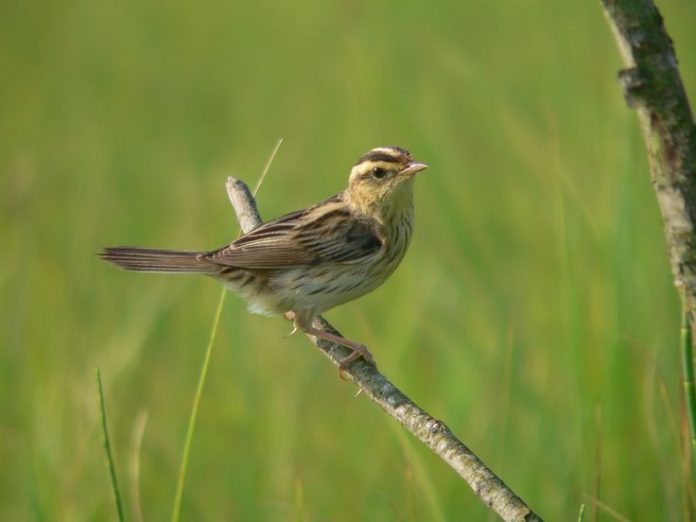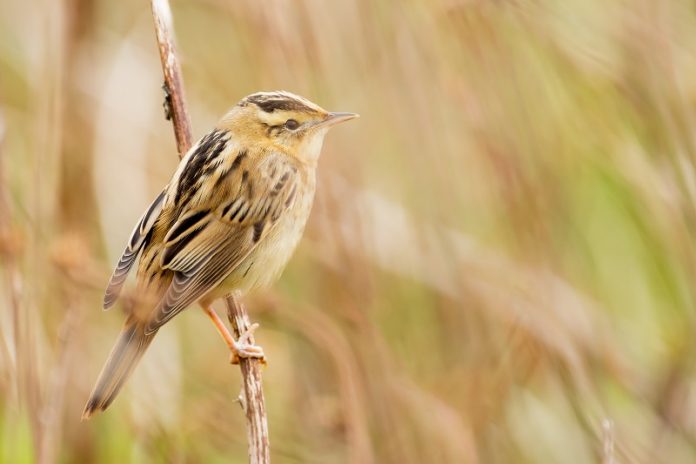Aquatic Warbler is medium size bird about 12.5 cm in length. It is skulking waterside warbler. Recalls Sedge Warbler in size and in having streaked upperparts and very obvious pale supercilium, but at all ages, Aquatic has much stronger black streaking on the mantle (bordered by obvious pale ‘tramlines’), clear pale central crown-stripe contrasting with black crown sides, pale lores, streaked back, rump and upper tail coverts, finely streaked breast and flanks, paler pinkish legs and more rounded tail (with pointed feather tips).
The pale central crown stripe can be overlooked if feathers are sleeked, especially when the bird was seen in profile, being most apparent if feathers are somewhat raised, but at all times the black crown sides contrast with the relatively paler sides of the head and unmarked lores in comparison with adult Sedge.
The upperparts, especially the mantle, have much broader and blacker striping than in Sedge, and in worn birds, the mantle becomes almost blackish. Although the back, rump, and upper tail coverts are streaked (unlike all but a very few Sedge), the streaking is narrower and less distinct than on the mantle and the subsequent contrast can make them appear unstreaked in a brief view.

The dullest, most worn adults are sandy grey-brown above with whitish supercilia and crown stripe, whereas in fresh plumage the pale areas have a noticeably yellowish-buff tinge both above and below. On dull adults, the streaked flanks and breast sides and much paler sides of the head and lores are the most helpful distinctions from Sedge, although some worn adults may show mottled, dusky loral area.
If flushed from underfoot, the rump of Aquatic appears less rufous than in Sedge, but contrast is shown between the weakly streaked rump and strongly striped mantle. Adults are distinctly duller than juveniles in both species. Juvenile Aquatic is a very prominent bird, being bright yellowish-buff overall with very sturdy black striping on upper parts, the heavily striped mantle viewing contrasting pale ‘tramlines’ at the sides as in the adult, and most have completely unmarked underparts (although a minority have weak dark mottling on breast).
Juvenile Sedge, however, is even more strikingly different from adult and recalls Aquatic (especially adult) in several features: it is much buffer and yellower than the adult, has a very pale central crown-stripe (which in some is seemingly unstreaked), shows dark mottling on breast, and some individuals can show weak streaking on the rump and upper tail coverts.
However, young Sedge lacks conspicuous broad, black striping on the mantle, paler lores, and clearly streaked rump and upper tail coverts of Aquatic and has indistinct dark mottling within the pale crown-stripe, which is never so prominent, narrow, and clean-cut as in the latter. In addition, does not show the rather prominent streaking on flanks typical of worn adult Aquatic.

Aquatic Warbler is notoriously more skulking than Sedge, even on breeding grounds, and especially so on passage. Outside breeding season, may be encountered feeding low in dense aquatic vegetation fringing reed-beds (less often in reeds themselves), particularly in areas inhabited by Sedge Warblers, when a direct comparison is often possible. Autumn adult is much drabber and more worn than fresh, brightly colored juvenile. Aquatic Warbler migrates in juvenile plumage.
The most frequently heard call, quite freely given on passage, a low ‘tuk’ or ‘chuk’, distinctly deeper than the related call of Sedge; also gives a dry ‘churrrr’. Aquatic Warbler song is less complex and much more monotonous than that of Sedge Warbler, with shorter and less varied phrases. Dry trills and short series of whistles are interspersed with marked pauses; can be rendered ‘trrrrr … dew-dew-dew-dew … churrrr … di-di-di-di …’. It lacks extensive mimicry and sweet notes so typical of Sedge. Aquatic Warbler song is usually given from among sedges, occasionally in short song flight.
It is uncommon, localized, and declining, but little recorded on the passage (but regular in autumn west to S Britain). Appears to be winter in the south of our region in parts of W Africa, but records are sparse. Inbreeding season favors marshes and fens with extensive coverage of sedges (Carex) and wet tussocky grassland. On passage occurs in a variety of freshwater wetlands, favoring stands of iris and other dense vegetation within or beside extensive reed beds.







